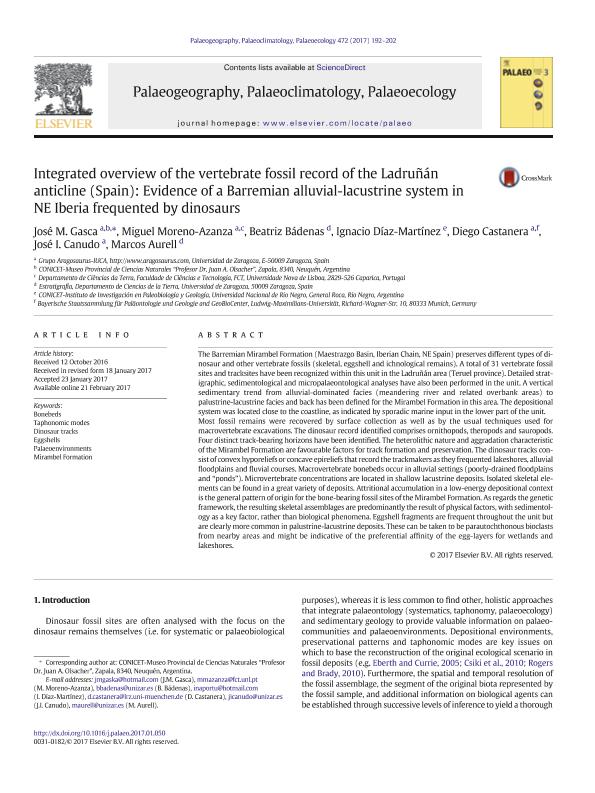Mostrar el registro sencillo del ítem
dc.contributor.author
Gasca Pérez, José Manuel

dc.contributor.author
Moreno Azanza, Miguel

dc.contributor.author
Bádenas, Beatriz
dc.contributor.author
Díaz Martínez, Ignacio

dc.contributor.author
Castanera, Diego
dc.contributor.author
Canudo, José I.
dc.contributor.author
Aurell, Marcos
dc.date.available
2018-08-31T15:25:50Z
dc.date.issued
2017-04
dc.identifier.citation
Gasca Pérez, José Manuel; Moreno Azanza, Miguel; Bádenas, Beatriz; Díaz Martínez, Ignacio; Castanera, Diego; et al.; Integrated overview of the vertebrate fossil record of the Ladruñán anticline (Spain): Evidence of a Barremian alluvial-lacustrine system in NE Iberia frequented by dinosaurs; Elsevier Science; Palaeogeography, Palaeoclimatology, Palaeoecology; 472; 4-2017; 192-202
dc.identifier.issn
0031-0182
dc.identifier.uri
http://hdl.handle.net/11336/57874
dc.description.abstract
The Barremian Mirambel Formation (Maestrazgo Basin, Iberian Chain, NE Spain) preserves different types of dinosaur and other vertebrate fossils (skeletal, eggshell and ichnological remains). A total of 31 vertebrate fossil sites and tracksites have been recognized within this unit in the Ladruñán area (Teruel province). Detailed stratigraphic, sedimentological and micropalaeontological analyses have also been performed in the unit. A vertical sedimentary trend from alluvial-dominated facies (meandering river and related overbank areas) to palustrine-lacustrine facies and back has been defined for the Mirambel Formation in this area. The depositional system was located close to the coastline, as indicated by sporadic marine input in the lower part of the unit. Most fossil remains were recovered by surface collection as well as by the usual techniques used for macrovertebrate excavations. The dinosaur record identified comprises ornithopods, theropods and sauropods. Four distinct track-bearing horizons have been identified. The heterolithic nature and aggradation characteristic of the Mirambel Formation are favourable factors for track formation and preservation. The dinosaur tracks consist of convex hyporeliefs or concave epireliefs that record the trackmakers as they frequented lakeshores, alluvial floodplains and fluvial courses. Macrovertebrate bonebeds occur in alluvial settings (poorly-drained floodplains and “ponds”). Microvertebrate concentrations are located in shallow lacustrine deposits. Isolated skeletal elements can be found in a great variety of deposits. Attritional accumulation in a low-energy depositional context is the general pattern of origin for the bone-bearing fossil sites of the Mirambel Formation. As regards the genetic framework, the resulting skeletal assemblages are predominantly the result of physical factors, with sedimentology as a key factor, rather than biological phenomena. Eggshell fragments are frequent throughout the unit but are clearly more common in palustrine-lacustrine deposits. These can be taken to be parautochthonous bioclasts from nearby areas and might be indicative of the preferential affinity of the egg-layers for wetlands and lakeshores.
dc.format
application/pdf
dc.language.iso
eng
dc.publisher
Elsevier Science

dc.rights
info:eu-repo/semantics/openAccess
dc.rights.uri
https://creativecommons.org/licenses/by-nc-sa/2.5/ar/
dc.subject
Bonebeds
dc.subject
Dinosaur Tracks
dc.subject
Eggshells
dc.subject
Mirambel Formation
dc.subject
Palaeoenvironments
dc.subject
Taphonomic Modes
dc.subject.classification
Meteorología y Ciencias Atmosféricas

dc.subject.classification
Ciencias de la Tierra y relacionadas con el Medio Ambiente

dc.subject.classification
CIENCIAS NATURALES Y EXACTAS

dc.title
Integrated overview of the vertebrate fossil record of the Ladruñán anticline (Spain): Evidence of a Barremian alluvial-lacustrine system in NE Iberia frequented by dinosaurs
dc.type
info:eu-repo/semantics/article
dc.type
info:ar-repo/semantics/artículo
dc.type
info:eu-repo/semantics/publishedVersion
dc.date.updated
2018-08-31T13:51:38Z
dc.journal.volume
472
dc.journal.pagination
192-202
dc.journal.pais
Países Bajos

dc.journal.ciudad
Amsterdam
dc.description.fil
Fil: Gasca Pérez, José Manuel. Consejo Nacional de Investigaciones Científicas y Técnicas; Argentina. Universidad de Zaragoza; España. Provincia de Neuquén. Ministerio de Energía, Ambiente y Servicios Públicos. Dirección Provincial de Minería. Museo Provincial de Ciencias Naturales Prof. "Dr. Juan A. Olsacher"; Argentina
dc.description.fil
Fil: Moreno Azanza, Miguel. Universidad de Zaragoza; España. Universidade Nova de Lisboa; Portugal
dc.description.fil
Fil: Bádenas, Beatriz. Universidad de Zaragoza; España
dc.description.fil
Fil: Díaz Martínez, Ignacio. Consejo Nacional de Investigaciones Científicas y Técnicas. Centro Científico Tecnológico Conicet - Patagonia Norte. Instituto de Investigación en Paleobiología y Geología; Argentina
dc.description.fil
Fil: Castanera, Diego. Universidad de Zaragoza; España. Ludwig-Maximilians-Universität; Alemania
dc.description.fil
Fil: Canudo, José I.. Universidad de Zaragoza; España
dc.description.fil
Fil: Aurell, Marcos. Universidad de Zaragoza; España
dc.journal.title
Palaeogeography, Palaeoclimatology, Palaeoecology

dc.relation.alternativeid
info:eu-repo/semantics/altIdentifier/doi/https://dx.doi.org/10.1016/j.palaeo.2017.01.050
dc.relation.alternativeid
info:eu-repo/semantics/altIdentifier/url/https://www.sciencedirect.com/science/article/pii/S0031018216305776
Archivos asociados
